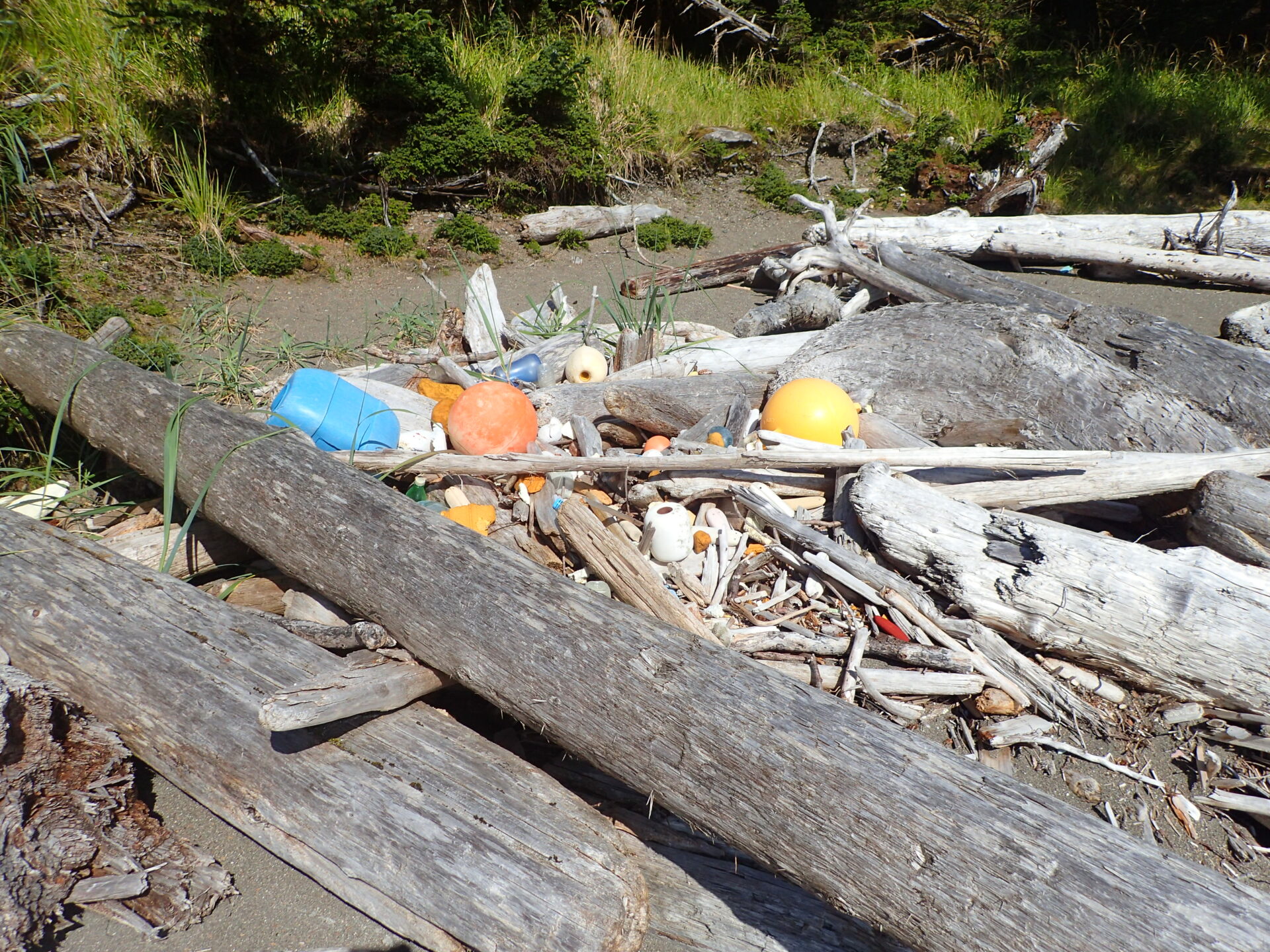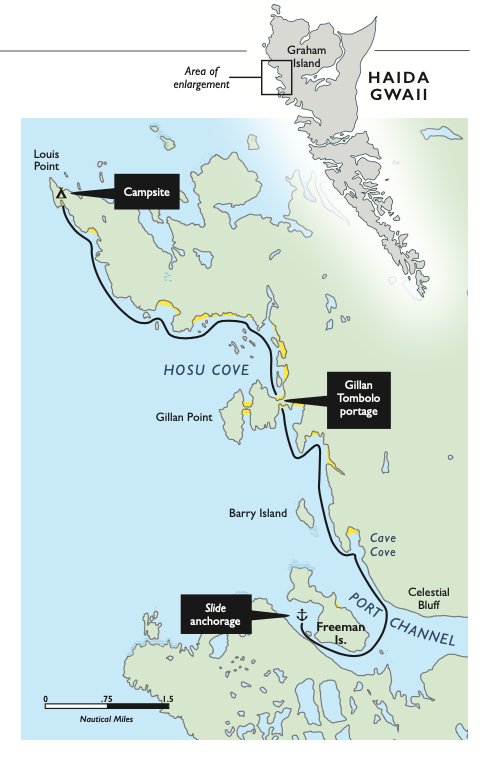There it is in the distance, the beach of your dreams.
The only problem is that there is absolutely no place close by to safely drop anchor and go explore for a while. After a few trips down the west coast of Haida Gwaii, and way too many disappointments at not being able to make shore for a little exploration, we came up with a new tactic: Shore camping with the tender.
It might seem a bit odd to leave behind a perfectly good yacht with down duvet comforters, indoor plumbing and all those other fluffy amenities to go camp-out on a rocky shoreline, but when beachcombing is the priority, sometimes the best option is to break away from comfort and head out for a few days in a smaller boat.
Shore camping with the tender is challenging and fun and has allowed us to beachcomb some very remote and rewarding beaches. Whether we find glass treasures, plastic bottles and other flotsam and jetsam, or just a spectacularly perfect shore, it’s always been well worth the effort.
In all honesty, we are a bit confused about the name of the cove we are in. Each map and reference book calls it something slightly different. Our cove may have a few names or none at all, but we are definitely behind Freeman Island in Port Channel on the west coast of Haida Gwaii.
We’ve been at anchor on our 32-foot O’Day sailboat for two days in this snug little cove. During that time the wind has danced around us at various speeds and we’ve swung around safely in the changing tides; we’re positive that the anchor has a firm set. The forecast for the next few days consists of calm seas and light variables so we find the bravery to finally venture out from Slide and our little cove for some further beachcombing and shore camping.

The beaches we’ve been dying to reach are along the outer edges of Graham Island. With no place to anchor and the area being poorly charted we didn’t dare get close when we passed them on our way into our anchorage. I could clearly see the rainbow of colours that mark heavy deposits of marine debris strewn along the shore and we were pretty excited to finally go take a closer look.
Our zodiac is only eight feet and we’ve brainstormed our essential supply list many times over the last two days. It still seems a bit full for me to climb into but I rearrange the obstacles around me until I’m comfortable and all is balanced. Dann walks the decks of Slide checking to ensure everything is as it should be, then he slides the doors closed and climbs into his position in the zodiac. Our little motor purrs healthily behind us as I untie our lines and push away from the mother ship. This will be our first time leaving Slide alone on her anchor overnight while on the west coast of Haida Gwaii. Dann swings us around so my back is to her and I breathe out the anxiety of leaving her alone.
Very quickly we leave the protection of Freeman Island and are picked up by an easy swell as we cross Port Channel. Dann notes the time, wanting to carefully keep track of our open water passages. It takes us 15 minutes to cross to the other side and we start to run close to the rocks below Celestial Bluff and through Cave Cove. Our next crossing is in front of us as we come out from behind Barry Island. The gentle giant swell now dwarfs us and has added a little chop. Dann calls the time and I lean back and hunch low.
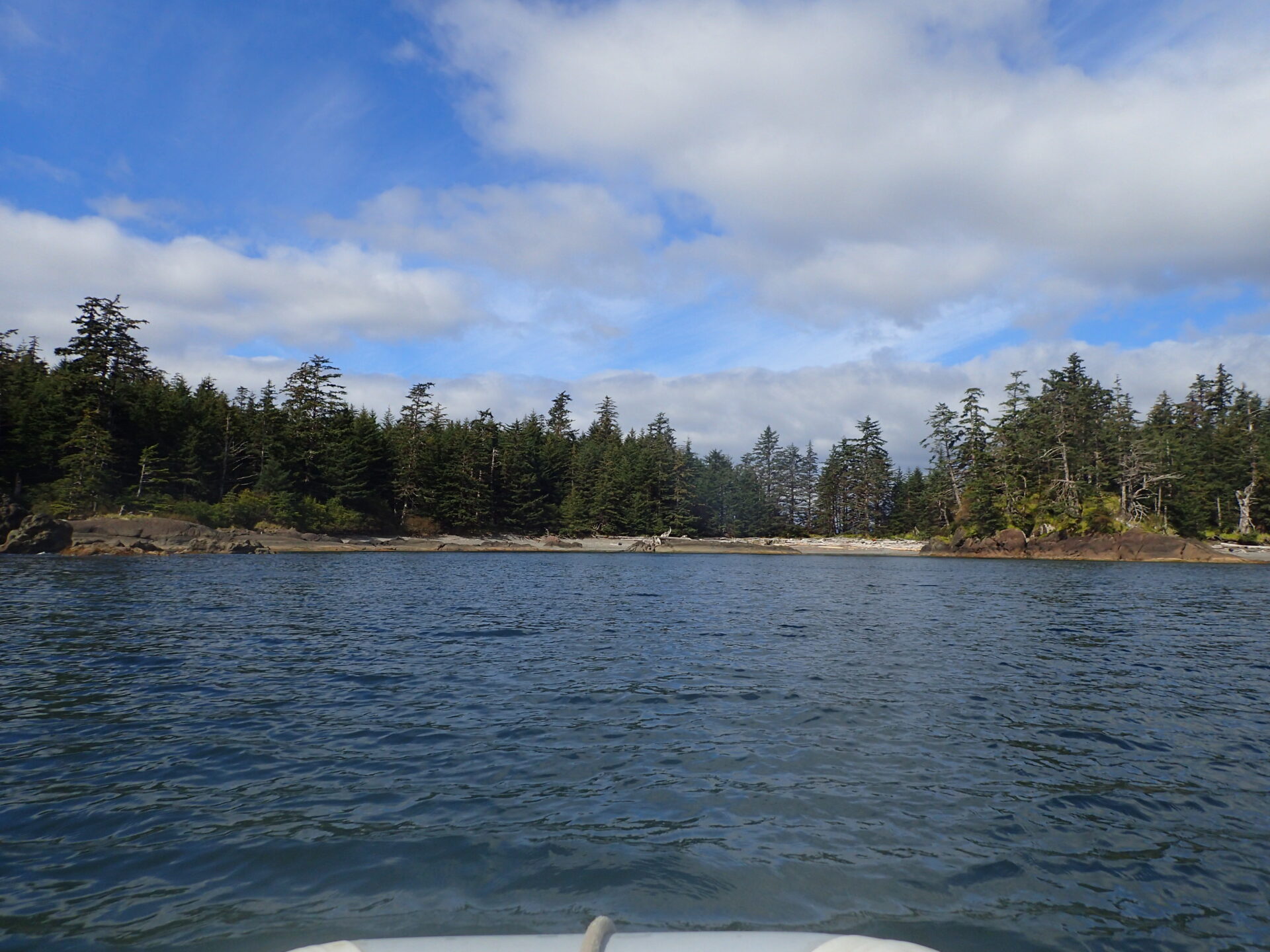
In 30 minutes we reach protected waters inside the arm of the Gillian Tombolo. We weave our way around shallow boulders marked by hairy soft kelp and land on a perfect pocket beach in bright beaming sunshine. The tide is falling and we tie off to a log while we do a quick exploration. The tiny beach we’ve landed on is packed with marine debris. After stretching our legs we gravitate back to the zodiac and start to unpack it, carrying our stuff up to the logs. When she’s empty, Dann removes the motor and we portage the boat above the log line, into the forest and through to Hosu Cove. A few more trips and all our stuff has been portaged.
We reload the zodiac and I go with it along the bay while Dann walks the shore. At fair intervals, we trade places and leapfrog the zodiac into the afternoon, always with one of us walking the shore and shifting through the debris for treasures. Eventually we reach Bluff Bay and decide to set up camp. Dann goes about lighting a small fire while I set up the tent and arrange a little kitchen out of driftwood. In the evening, we walk out to Louis Point until the sunset signals us back to our camp.
For our efforts, we’ve been rewarded with two glass balls; a mysterious GoPro camera, dry in its waterproof case; three West Coast Fishing Resort ball caps; three unique glass bottles and a kayak paddle. It’s mostly garbage but we’re ecstatic.
Our legs are sore from walking the rugged shoreline and cutting through the forest when we needed to, so our bed on the mossy forest floor feels fit for royalty. I fall asleep listening to the different sounds of the ocean. The swell makes a slow sucking crash on the big outer rocks of the bay, and inside little ripples move along the pebble beach. The sky is clear and the forest is still. Above us the stars perform a sparkling show punctuated with meteorites. We rest easily.
In the morning, we follow our path backward with each of us walking the piece of beach that the other one did last. Our new angle into the driftwood helps us find two more glass bottles and another ball cap. The wind has come up from nothing to a gentle puff now and again, just enough to keep us from dawdling.
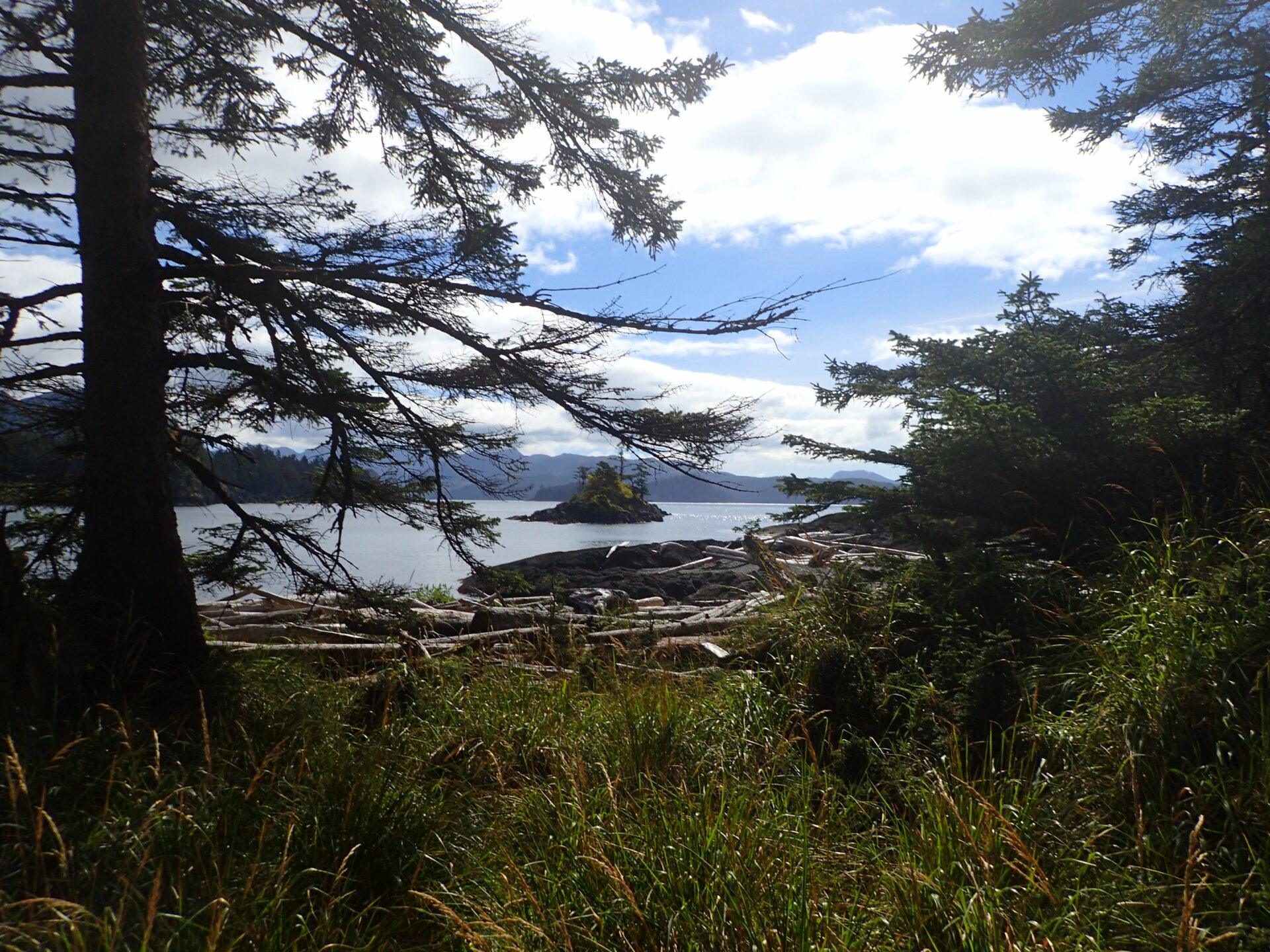
After portaging the zodiac back through the forest and over the tombolo we decide to skim the edges of Athlow Bay, continuing to beachcomb rather than head straight across Port Channel. Even though these beaches are slightly more protected from the prevailing elements, they’re still packed with colourful flotsam and we collect three more hats from local fishing resorts.
It’s around 18:00 and the evening is setting in by the time we start to make our way across the open waters of Port Channel. We’ve been away from Slide for 32 hours and are thrilled when we round the corner and see her bobbing in a gentle breeze, waiting for us exactly where we left her.
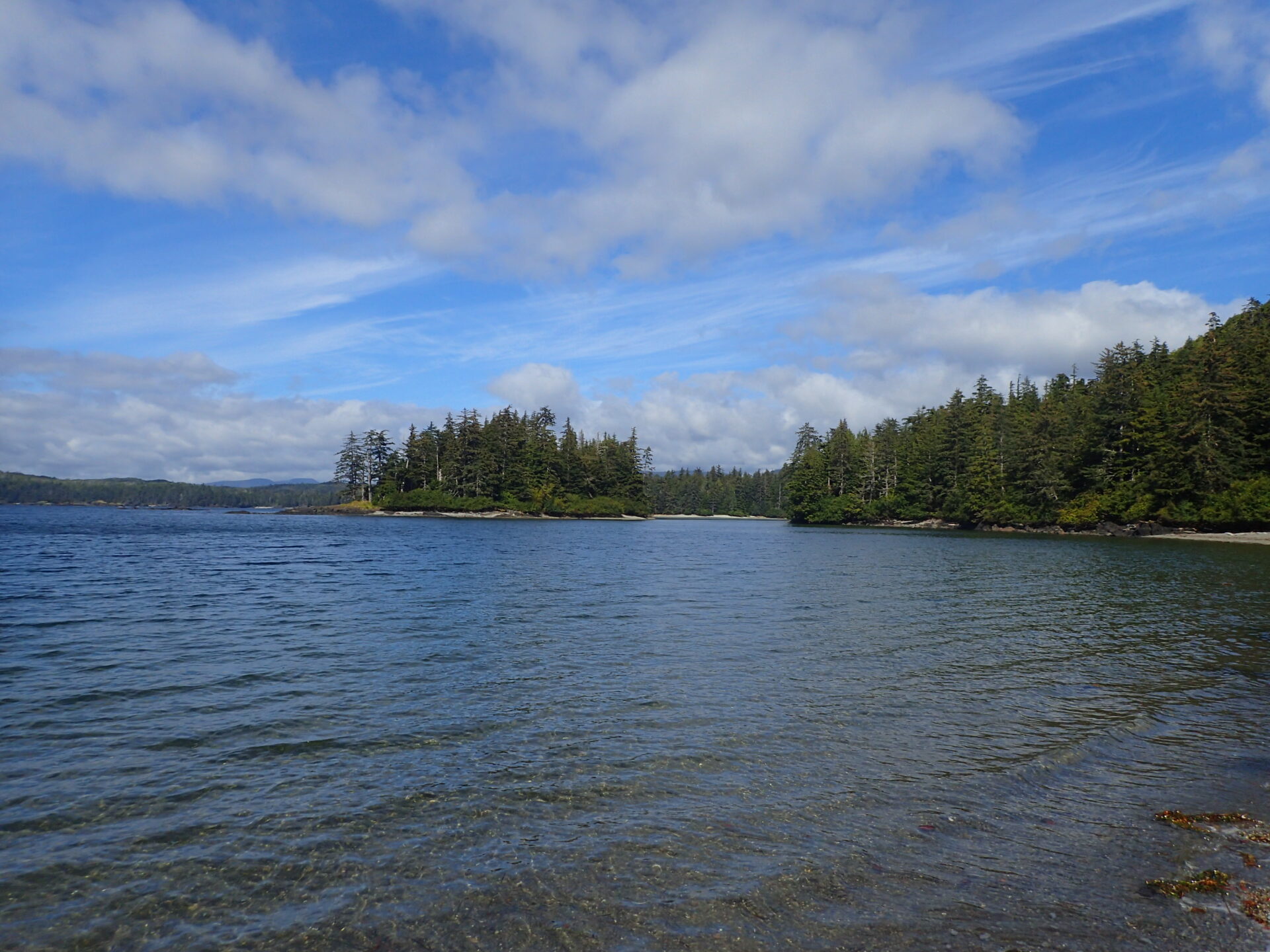
The rigging sings and ticks happily as we climb aboard. For the rest of the evening we play with our treasures and consult the books and charts about the beaches we’ve just explored, adding personal details to them and marking uncharted rocks and cool landmarks. Before we go to bed we’ve already scoped out our next anchorage close to the faraway beaches we’d like to explore, and all that’s left to do is wait for the right weather to give us a chance to reach them.
As I said earlier, shore camping might not be something that everyone is interested in. After all, your yacht has already brought you to a beautiful, secluded place on the planet, does one really need to push further?
For us the answer is an easy “yes.” We love to poke our noses into places that haven’t seen humans for years and we’ll do our best to find a way.
Shore Camping Tips
6 Essential Lessons I’ve learned
- Plan your route and know it well. We spend a lot of time cruising the coast and getting to know the personalities of the beaches we want to explore before making our plan to reach them.
- Memorize landmarks. The last thing you want is to be lost on a remote stretch of coastline.
- Make sure you’re travelling within the range of the fuel you carry in your tender, and have several safe options to land and pull your small craft out of the water.
- Learn the history of the places you want to visit and gather local knowledge from other people. It will help in knowing what you’re up against.
- Choose the best weather and take no risks.
- Tell someone your plan. When we leave, we’re never able to tell our family exactly if and when we’ll be hitting a remote beach. The weather could change and we might not get our chance, or we could end up trying for an altogether different area than originally planned. So, we’ve acquired a SPOT device to check-in with them and keep them posted on our movements. On top of this we leave a detailed letter aboard our sailboat describing our intended route, the time we left and our intended date to return in case someone stumbles across her, lonely in the anchorage.
Essential Gear List
(Above and beyond the standard fuel and safety equipment for a small boat)
• Two handheld radios and each of us always has one on our person. We also carry a SPOT messenger device and have predesignated check-in times with family.
• Flagging tape, a GPS and a compass.
• A few sources of fire starter. We each carry our own in safe waterproof stashes. We do all our cooking on small fires below the tide line to avoid carrying stoves and extra fuel canisters.
• A tent (though we’ve gone with as little as a tarp), sleeping bags, a spare tarp, spare rope, sleeping pads, a pan, two bowls and forks, two water flasks and a knife each.
• Water takes up a huge amount of space for us. If we’re going a long way, knowing we’ll be making our way back, we usually drop off stashes of water to lighten our load as we go.
• A meal plan helps when packing the food. We burn a lot of energy hiking the shore and spoil ourselves with good meals to keep us going. I’ll often pre-make our dinners and wrap them in packages of tinfoil so all we have to do is cook it in a bed of coals.
• One change of clothes each packed in a dry bag.
• One large backpack that has the food and camping supplies and a small backpack for hiking with.
• A camera and smart phones (packed in a dry bag or waterproof case).

